TL;DR – Content distribution is the art of getting more eyes on your content. The PESO model (Paid, Earned, Shared, and Owned) offers different ways to accomplish that, depending on your goals and content marketing budget.
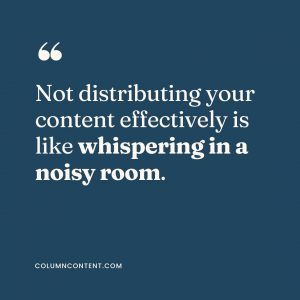
The most well-crafted article or video is useless if no one sees it. Content is king, but distribution is queen.
And content distribution is more than just hitting the “publish” button.
The goal is to maximize reach and brand awareness and build a loyal audience.
Why care about content distribution?
If you’re not distributing your content effectively, you’re essentially whispering in a noisy room. No one will hear you.
Unless you’re already a household name, you need sufficient distribution to get your content in front of people who’ve never heard of you.
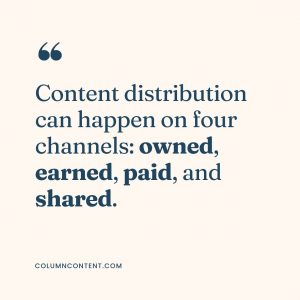
Types of content you can distribute
Before you start scattering your content to the wind, take stock of what you have.
As part of your content strategy, you likely create or have one or more content type from the following list:
- Blog post
- White paper
- Case study
- Infographic
- Podcast episode
- and more
Each content type has an ideal channel for distribution.
For instance, in-depth research studies might be best suited for academic platforms or LinkedIn, while quick tips and tricks could gain traction on Twitter or Instagram.
The 4 content distribution channels
Content distribution channels come in four main categories: owned, earned, paid, and shared. Each has its pros and cons.
- Owned channels are the platforms you control, like your website or email list. Owned channels give you complete control but might have limited reach.
- Earned channels are platforms where others share your content for free, like a guest post on a popular blog. Earned channels can offer a lot of reach but give you less control.
- Paid channels are pretty self-explanatory; you pay to get your content featured somewhere. Paid channels can get you immediate results but at a cost.
- Shared channels are collaborative platforms where you and others can jointly contribute and share content. Shared channels offer a mix of control and reach but require a collaborative effort.
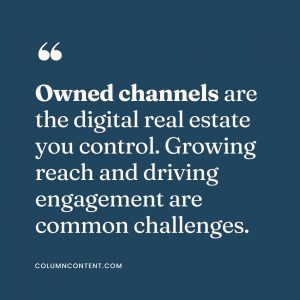
Choosing the right content distribution channel requires careful planning.
For instance, a paid channel can give you quick results, but the moment you stop paying, the traffic dries up.
On the other hand, organic distribution platforms like your own website or social media profile may take time to build momentum, but offer more sustainable growth.
The trick is to find a balance between the two.
Owned channels
Owned channels are the digital real estate you control, such as your website, blog, or email newsletter.
They serve as the foundation of your content distribution strategy, offering a level of control that other channels simply can’t match.
However, this control comes with its own set of responsibilities and challenges.
First, let’s talk about customization.
Owned channels allow you to tailor the user experience to your brand’s specific needs.
You can adjust the layout, design, and create interactive content to align with your goals.
This level of customization is a double-edged sword; while it gives you the freedom to create an ideal environment for your audience, it also requires ongoing maintenance and resources to keep it functioning.
Next, there’s the issue of reach.
Owned channels often start with a limited audience, usually composed of people already familiar with your brand.
Growing this audience requires a consistent and high-quality content output, coupled with effective search engine optimization (SEO) and possibly some promotional efforts through other channels.
It’s a long-term game that demands patience and strategic planning.
Another challenge is engagement.
Since you control the platform, it’s up to you to keep the audience engaged.
This means not just producing content, but also interacting with your audience through comments, emails, or even live chats.
Lastly, there’s the matter of data collection and analysis.
Owned channels offer the advantage of direct access to user data.
You can track everything from basic digital marketing metrics like page views, bounce rates, time spent on page, and click-through rates to more complex data like user flow and conversion paths.
This wealth of information is invaluable for refining your strategy, but it also requires the skills and tools to analyze and interpret it effectively.
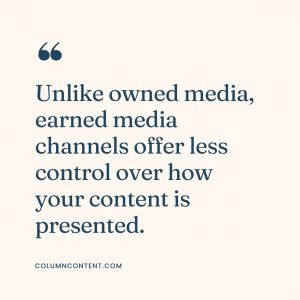
Earned channels
Earned channels are the platforms where your content gets shared or featured without you having to pay for it.
This could be anything from a guest post on a reputable blog to a mention in a news article or a share by a social media influencer.
While earned media can offer significant reach and credibility, they come with their own set of challenges and considerations.
Firstly, there’s the issue of control.
Unlike owned media, where you have full authority over how your content is presented, earned channels offer less control.
You’re at the mercy of the platform or content creator sharing your content, which means you can’t always dictate the narrative or presentation.
This makes it crucial to build strong relationships with the people or platforms that can share your content, ensuring they understand your brand and message.
Secondly, there’s the challenge of consistency.
Earned channels often require a steady stream of high-quality content to maintain visibility and engagement.
One guest post or social media mention might give you a temporary boost, but sustaining that level of attention requires ongoing effort.
You’ll need to continually produce content that is share-worthy and aligns with the platforms or individuals who are most likely to share it.
Lastly, there’s the question of measurement.
Unlike owned or paid channels, where you can easily track metrics like clicks, impressions, and conversions, earned channels are often harder to quantify.
You might know that a particular blog post or social media share led to increased traffic, but tying that directly to conversions or other key performance indicators can be challenging.
In essence, earned channels offer a valuable opportunity for increased visibility and credibility, but they require a nuanced approach.
Building relationships, maintaining a consistent output of quality content, and finding ways to measure your success are the name of the game.

Paid distribution
Paid distribution channels are the fast lane of content distribution.
You pay for the privilege of immediate visibility, whether that’s through sponsored posts, social media ads, or a Google ad.
The allure of quick results is strong, but it’s essential to approach paid channels with caution.
The first challenge is budgeting.
It’s easy to get carried away and overspend, especially when you see immediate spikes in traffic or engagement.
This can skew how you view and measure your content marketing strategy.
However, you need to keep an eye on your return on investment. Are these new visitors converting into customers, or are they just window-shopping?
You need to know what you’re getting for your money, and that requires meticulous tracking and analysis.
The second challenge is sustainability.
Paid content distribution can give you a quick win, but what happens when the campaign ends or the budget runs out?
Often, you’ll see a sharp decline in the metrics you were just celebrating.
That’s why it’s crucial to use paid channels as part of a broader strategy, one that includes owned, earned, and shared channels to maintain momentum.
Lastly, there’s the issue of audience quality.
While paid channels can undoubtedly increase your reach, they don’t always bring in the most engaged or loyal audience members.
People who come to your content through a Google ad or sponsored content may not have the same level of interest or intent as those who find you through an organic search or a trusted recommendation.
Sure, paid channels offer the allure of quick results but come with their own set of complexities.
But when used judiciously and as part of a well-rounded strategy, paid channels can indeed be a powerful tool in your content distribution arsenal.

Shared channels
Shared channels are often overlooked, but they hold significant potential. These are platforms where you collaborate with others to share content.
Think of it as a mutual benefit society; you share someone else’s content, and they share yours.
This could be as simple as posting into a Slack group, online forum, or through a content partnership with another brand.
The beauty of shared channels is they allow you to tap into a new audience without the costs associated with paid channels.
You’re essentially doubling your reach without doubling your budget. However, shared channels come with their own set of challenges.
The most significant being finding the right partners or communities.
You may need to collaborate with individuals or organizations that share your target audience but aren’t direct competitors.
Another challenge is maintaining content quality.
Partners must create content that meets your standards, and your brand must share content in communities that meets their standards.
This requires clear communication and often, a set of guidelines for what can and cannot be shared.
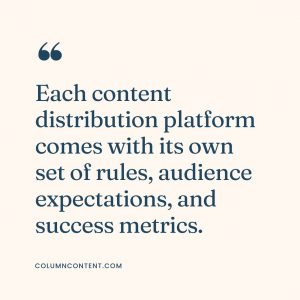
Crafting a winning strategy
So, how do you bring all this together into a cohesive content distribution strategy?
Start by understanding your target audience. Ask yourself:
- Who will benefit most from your content?
- What are their pain points?
- What questions are they asking?
- Where do they hang out online?
- What kind of content do they consume?
You can use content marketing tools like Ahrefs, SparkToro, or simple customer surveys to gather this information.
The more you know about your audience, the more effectively you can target them.
Leverage existing content
You don’t have to start from scratch. Take a look at the content you already have and see how it’s performing.
Use tools like Google Analytics to identify which pieces are getting the most engagement, traffic, or conversions.
These are your star players, and you should consider pushing them out through additional channels.
For example, a recent post that’s doing well could be repurposed into a social media post, an infographic, or even a podcast episode.

Choosing your media channels wisely
Once you’ve got a good handle on your audience and your existing content, it’s time to choose your distribution channels.
This isn’t a decision to make lightly. Each content distribution platform comes with its own set of rules, audience expectations, and metrics for success.
For instance, if you find that your audience engages more on LinkedIn and ignores other social media platforms, then it makes sense to focus your efforts on LinkedIn posts.
Tracking and tweaking
Once your content is out in the world, your job isn’t done. You need to track how it’s performing and be ready to make tweaks.
This could mean adjusting the copy on a poorly performing ad or doubling down on a successful guest post with a follow-up article.
The key is to be responsive and adapt your strategy as you go along. Content distribution isn’t a one-and-done deal; it’s a long-term commitment.
Building a loyal audience takes time, consistent effort, and a willingness to adapt.





